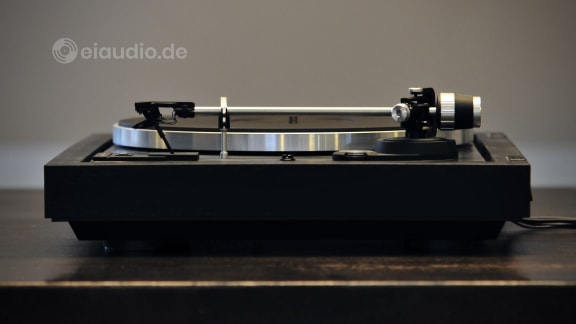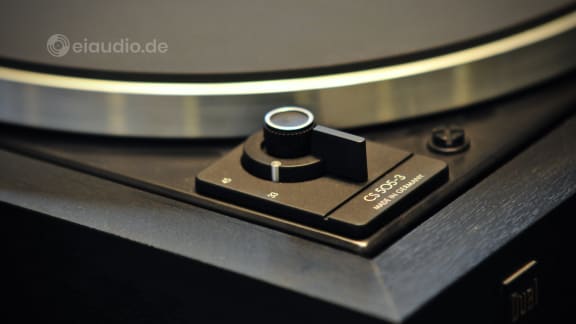Dual CS 505-3 Audiophile Concept
Published: 03/02/2022
Manufacturing date: 1987
Author: Karsten Hein
Category: Gear & Review
Tag(s): Turntables
The CS 505-3 is a semi-automatic turntable with full-size suspended sub-chassis that effectively protects the unit's drive mechanism from external vibrations. The 505 features a straight, tubular, high torsion aluminium tonearm measuring just over 22cm in length, and a low-resonance, non-magnetic platter that is driven by a 16-pole-synchronous Dual motor and belt-drive mechanism. The turntable's basic design and layout have been tried and tested and it can, at the time of writing this, still be purchased new, in the form of the revised Dual CS 505-4 that is built by Alfred Fehrenbacher’s Dual Phono GmbH, in the company’s original home town of St. Georgen. The factory is located deep in the Black Forrest, a region famous for its customs, folklore, and precision clockwork mechanisms.
The CS 505-3’s semi-automatic drive unit is easy to operate. Moving the tonearm in position over the record will automatically set the platter in motion at the pre-selected speed. The tonearm initially remains in raised position, until a lever is flipped to gently put it down. The platter stops spinning automatically when the stylus reaches the end of a record, and the tonearm is automatically raised once again. On our unit, there was a mild plopping sound as the turntable shut off. It was probably caused by the tonearm lifting rather abruptly. However, this is just meant as an observation and not as complaint. I was at first a little surprised by the phenomenon, but it never really bothered me. The tonearm remains raised and then needs to be returned to the start position by hand.
In 1987, the first CS 505-3 sold for just under 500.00 DM, (96.00 GBP) and modern customers of its successor, the CS 505-4, are once again asked to pay the same in euros. This might seem a bit pricey in both cases. However, having listened to the CS 505-3 perform in our living room for some days, I feel it is still quite a good deal. More so than our Sansui 525, the Dual with its original ULM 65 E cartridge and elliptical diamond stylus had me listening to one record after another, enjoying its charming sincerity and musical drive. But what was it exactly that enthralled me?
Advert eiaudio/shop:
I have always been fond of the Thorens 318 turntable design for getting the balance between technical sophistication and elegant understatement right. As if its engineers had taken their pointers from Japanese furniture design, more so than the tech-savvy Japanese electronics industry ever had by itself. And I found very similar design choices to be present in the Dual CS 505-3, especially in combination with its black, wooden plinth. Sadly, most turntables of those days still featured permanent interconnects which made it difficult to make adjustments to the sonic balance by means of connection alone. I would have loved to attach my favourite silver solid-core cables, of course.
The ULM 65 E was the original Dual cartridge for the 505-3 to which an Ortofon-made, bonded, elliptical, diamond stylus was attached. The ULM was not a High End cartridge and only offered a limited frequency bandwidth of 10-25,000 Hertz. Channel separation was also not impressive at 20dB. And still, it offered considerable output rated at 4 mV. This suggested that it could play loud. The combination of cartridge, stylus, and drive unit worked quite well, but also showed some obvious weaknesses that one could find either off-putting or endearing, case by case.
I first whipped out a bad pressing of Norah Jones’ album “Come Away With Me”, and was disappointed that the Dual’s elliptical stylus brought out lots of sibilance that our Sansui 505 with AT VM 95 ML cartridge had so well hidden. This was not surprising perhaps, considering how deeply the micro-linear stylus of the AT could reach into the groove. The record sounded worse the closer the stylus moved to the centre. I next put on Stacey Kent’s album “I Know I Dream” and was surprised by a pleasant forward drive and rhythm that instantly made me tap my foot. I loved how Stacey’s voice seemed stronger, more direct, and also more engaging than I was used to. The music sounded slightly less delicate and did not reveal transients so well, but I did not miss this somehow.
Advert eiaudio/shop:
The Dual’s ferocious and rhythmically engaging character had me smiling several times though the album. “I Know I Dream” being a good pressing, I had no issues with sibilance whatsoever. I noticed that voices were perhaps not revealed in the most authentic fashion and could sound a little “vintage” at times. They did not manage to free themselves from the instruments as much as I was used to, but, in the overall scheme of things, were endearing and lots of fun to listen to. If I had first thought about replacing the permanent interconnects with RCA jacks and upgrading the cartridge to a modern one with a more sophisticated stylus and better specs, every time that I came back listened I decided that any updates or upgrades could wait for another day.
Dual Company History
Christian and Joseph Steidinger started out as a manufacturer of clockwork and gramophone in the German Back Forest town of St. Georgen in 1907. The original company simply bore the family name, until they rebranded as Dual in 1927. The new company name was chosen in reference to their signature “dual-mode” power supplies in which they were true pioneers. Gramophones featuring these supplies, could either be powered by electricity or wound up for playback. Given their early success as a parts supplier, the Steidinger brothers began designing their own turntables.
During the German economic recovery that followed World War II, Dual became the largest producer of turntables in Europe. The German economy still enjoyed a price advantage over the rest of Europe and became known for high-quality once again. The Steidinger brothers had to hire up to 3,000 factory staff in order to keep up with the growing demand in entertainment devices in the world. Although Dual stretched the brand into other consumer electronics items, their turntables have remained iconic to this day.
The original Dual company went bankrupt in the early 1980s, following a decade of fierce competition from cheap and sophisticated imports from Japan. It was sold to the French electronics group Thomson SA. In 1988, the German company Schneider Rundfunkwerke AG bought Dual and then spun off the ‘Dual Phono GmbH’ to Alfred Fehrenbacher in 1993. Fehrenbacher produces Dual turntables 'Made in Germany', in the Black Forest town of St. Georgen, based on Dual’s original product lines until this very day.
Specifications
- Concept: suspended chassis, belt-drive
- Drive unit: 16-pole-synchronous motor
- Motor type: Dual SM 100-1
- Power consumption: 8 Watts
- Platter: non-magnetic, 1.2 kg
- Platter speeds: 33 1/2 and 45 RPM
- Pitch control: +/- 6%
- Wow and Flutter: 0.06% (WRMS 0.035%)
- Rumble: 52 dB (75% weighted)
- Channel separation: > 25 dB
- Channel balance: < 2 dB
- Arm length: 221 mm
- Offset angle: 24” 30’
- Tracking error: 0,15 “/cm
- Cartridge type: Dual ULM 65 E
- Cartridge system: moving magnet (MM)
- Stylus model: Ortofon DN 165 E
- Stylus type: elliptical diamond, bonded
- Tracking force: 15 mN (10-20 mN)
- Frequency range: 10-25,000 Hz
- Output: 4 mV / 5cms (1,000 Hz)
- Compliance: (h) 25 um/mN; (v) 30 um/mN
- Cartridge weight: 2.5 g
- Total capacitance: 160 pF
- Dimensions: (W) 437mm; (D) 369mm; (H) 138mm
- Weight: 6kg
- Country of manufacture: Germany
- Year(s): 1987-1990







